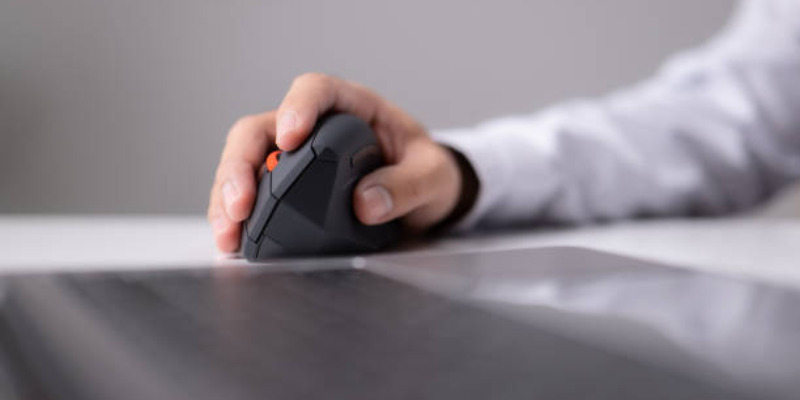How To Select An Ergonomic Mouse For Long Hours
A mouse is one of the most disregarded peripherals for long hours of computer use. Choosing an ergonomic mouse is less about making a fashion statement and more about reducing strain on your wrist and supporting your well-being long-term. In this article, we will define the ergonomics of a computer mouse, explain how various models differ, and discuss the most critical aspects to look out for before buying one.
A mouse is one of the most disregarded peripherals for long hours of computer use. Choosing an ergonomic mouse is less about making a fashion statement and more about reducing strain on your wrist and supporting your well-being long-term. In this article, we will define the ergonomics of a computer mouse, explain how various models differ, and discuss the most critical aspects to look out for before buying one.
Ergonomic Mouse Definition
While the traditional mouse relies on ergonomic mice, an ergonomic mouse tries to offer proper wrist and hand support. Unlike norm mice that usually pivot your wrist into twisted flattened postures, ergonomic designs focus on supinated postures. This means when using this kind of mouse, your palm is closer to a handshake position, which is more relaxed. Whether it is a vertical mouse that keeps your hand straight or a contoured design that grabs your palm, the objective is always the same: minimizing repetitive Stress that causes carpal tunnel syndrome and tendonitis.

According to research, it is possible to improve one's muscle fatigue and even posture with the help of an ergonomic mouse. When personal computer users switch to using these ergonomic mice, they have reported less discomfort and aching on their wrists and arms than when they use the when mice. This is achieved through enhanced muscle engagement since the hand's wrist and forearm are positioned more ergonomically by reducing the work done by small muscles and increasing the engagement of larger muscles.
Important Things To Consider
There are several key features you should look for in an ergonomic mouse.
Shape and Size:
Choose the mouse that best matches the size of your palm. While larger mice offer palm support, they may, in some instances, tighten grips. Smaller mice are more straightforward to grip for those with petite hands. Your palm's natural resting position should not resemble clenching a fist at any time.
Grip Style:
Different styles assume different grips on the mouse. If you are well-acquainted with palm grips, a mouse designed for palms suits you better. If you use claw grips, these mice may not work. It is best to try out the mouse to see what best suits your comfort.
Button Configuration:
The sensitivity and placement of buttons are essential. They should not be tough to click on. If you have to perform repetitive activities, the option to customize buttons can be helpful by reducing the movement required by your hand.
Wired vs. Wireless:
A wireless model benefits freedom of movement and office clutter. On the other hand, if staying connected at all times is more important and the extra cord does not bother you, a wired mouse might be the better choice. Regardless, ensure the mouse's design is conducive to your ergonomic needs.
Adjustability and Customization:
Heavier models tend to have adjustments for the tilt angle and the mouse's sensitivity (DPI). These attributes assist in tuning the mouse to fit your needs per work session, ensuring that it functions as required during more extended work periods.
Evaluation Of Multiple Ergonomic Concepts
All ergonomic mice have different features and benefits, such as the following.
Vertical Mice:
Most leading brands offer vertical mice that rest your hand in a shaky position. This design minimizes wrist rotation and reduces strain on the smaller muscles. After some time, many users report much less discomfort using vertical mice than traditional mice.
Contoured or Curved Mice:
These models are for hand types of a specific contour. They are designed to support the palm and ease the exertion required to move the mouse. As such, they are handy for people who commonly suffer from tiredness in the forearm.
Trackball Mice:
Instead of moving the trackball mouse, you rotate a ball using the palm or fingers to move the cursor. This can be useful for people with small computer desks or who want to minimize the movement of their wrists. However, these people must get used to this concept if they use trackball mice in office settings.

Hybrid Models:
Some ergonomic mice integrate vertical designs with other mouse styles. These include mice with vertical grips and customizable buttons, blending comfort and functionality.
Practical Implications For Long-Term Use
Purchasing an ergonomic mouse is not solely for comfort; it is a choice that will benefit your health and productivity in the long run. Take note of these implications:
Regular Muscular Relief:
An ergonomic mouse encourages a more natural hand position, resulting in less muscle strain in the wrist, forearm, and shoulder areas. This can significantly reduce the chances of developing repetitive strain disorders.
Better Productivity:
If your hand feels comfortable at rest, you will be free of fatigue or pain and can work uninterrupted for longer. Additional features like programable buttons and adjustable sensitivity also help you fine-tune your work as tasks become more straightforward and manageable.
Better Posture:
In general, ergonomic mice also lead to better posture, as these devices tend to encourage movement from the arm instead of just the wrist to scroll, relieving Stress on small muscles and resulting in healthier upper body positioning.
Adaptation Period:
If you switch to an ergonomic mouse, you might need to adapt. While your hand might feel "different" after some use, most users state that the benefits outweigh the initial discomfort.
How To Choose The Best Ergonomic Mouse For You
You should consider these questions before arriving at a decision:
What’s Your Hand Size And Grip Style?
If necessary, measure your hand and consider how you naturally grip and use a mouse. TryTry several models at a store or look up reviews where users comment on their comfort and fit.
What’s Your Daily Usage?
A more adjustable ergonomic mouse will benefit you if you use a desktop. A lower-priced model works fine if you use your desktop occasionally.
Do You Need Extra Features?
Depending on the nature of the work, extra features such as buttons or adjustable DPI can benefit you. These functions can yield faster output with minimum effort for creative users and gamers.
What’s Your Budget?
Ergonomic mice range in price from low-end to high-end. While grabbing the cheapest option available can be tempting, remember the health benefits of having a model meant for prolonged use.
Are You Willing to Adapt?
Specific ergonomic designs, such as vertical mice, need some time to adapt. If you are willing to endure a short period of discomfort in exchange for long-term benefits, these models could be ideal.

Steps To a Comfortable Mouse Experience
Opting for an ergonomic mouse offers numerous benefits, especially in the long term. Before deciding, consider your hand size, use habits, and comfort level. Whether you go forward with a vertical mouse, which reduces the amount your wrist has to twist, or a contoured mouse that rests your entire hand, the right device enables you to work longer and more efficiently. Try varying models, and don't fret over the short period of discomfort; it is all part of adjusting to what works best for you.